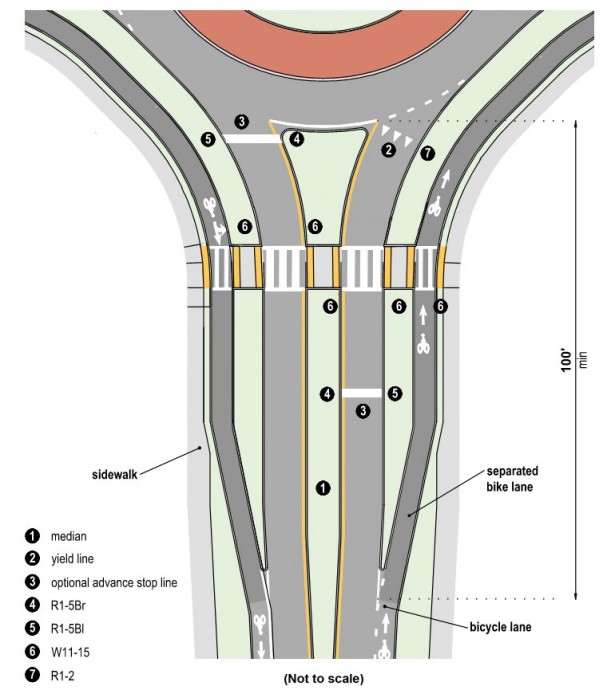18.5.6 Roundabouts
provides guidance on roundabouts, which provide non-signalized traffic control at intersections with a circulating lane (or lanes) around a central island traveling counterclockwise
While the Highly Confident bicyclist may be comfortable traversing a roundabout in a shared lane environment, many bicyclists will not feel comfortable navigating roundabouts with vehicular traffic, especially multilane roundabouts. Per the
, standard bike lanes are not permitted to be located within the circulatory roadway of a roundabout. For comfort and safety reasons, roundabouts may be designed to facilitate bicycle travel outside of the circular roadway on a separated bike lane or shared use path.
This transition from on-road to separated bikeway should be located a minimum of 100-ft from the edge of the roundabout circulatory roadway (see
and
). If on-street bike lanes are present, they should be terminated in advance of the roundabout at the transition to the separated bikeway. As shown on
, a bicycle ramp should be provided to transition between an on-street bikeway and a raised bikeway, such as a shared use path. Designers should provide an appropriate taper of the bike lane to narrow the entry width for the roundabout to only the motorist travel lanes. The bike lane line should be dotted for 50 to 200-ft in advance of the taper to provide guidance to bicyclists who wish to travel the roundabout in the shared lane.

Figure 18-55: Typical Layout of Bike Lane Transitions to Shared Use Path at Multilane Roundabout with Bike Ramps
(Refer to the
and
for additional signing and pavement marking guidance.)
When separated bike lanes are provided on approaches to roundabouts, they may be continued around the intersection by maintaining their separation from the roadway to maintain the continuity of the bikeway. When bike lanes are provided on approaches to roundabouts, and if it is desirable to maintain separation between bicyclists and pedestrians, the bike lanes may transition to separated bike lanes around the roundabout. Standard bicycle lanes are not allowed within roundabouts. Separated bike lanes at roundabout crossings should provide the following features:
- Stop and yield control for motorists at the bicycle and/or pedestrian crossing;
- Channelizing islands or detectable surfaces to maintain separation between bicyclists and pedestrians throughout the crossings;
- BICYCLE/PEDESTRIAN WARNING (W11- 15) signs at the bicycle and pedestrian crossings; and
- STOP HERE FOR PEDESTRIANS AND BICYCLES (R1-5b modified) sign, supplemented with stop bars may be considered for bike crossings at roundabout exits to reinforce motorist stopping and yielding.
Additional signs or pavement markings may be appropriate to reinforce the bicyclist’s and motorist’s responsibility to stop and yield.

Figure 18-56: Typical Layout of Separated Bike Lanes at Roundabout
(Refer to the
and
for additional signing and pavement marking guidance.)
When shared use paths are provided approaching a roundabout, they should be continuous around the circulating roadway. Shared use path design at roundabouts is similar to separated bike lane design, and should include the following features:
- Minimum shared use path width of 10- ft;
- Widened curb ramps that match the shared use path width at crosswalks to facilitate pedestrians and bicyclists at the crossings;
- Supplemental stop bars for crossings at roundabout exits to reinforce motorist stopping and yielding;
- BICYCLE/PEDESTRIAN WARNING (W11- 15) signs at the shared use path crossings; and
- Bicycle crossing/conflict markings to delineate the bicyclist path of travel may be provided.
At multilane roundabouts at least one of the following additional treatments to alert motorists to the presence of pedestrians or to require them to slow or stop traffic may be required to accommodate people with disabilities at the crossing:
- A raised crosswalk;
- An actuated rapid flashing beacon;
- A pedestrian hybrid beacon; and
- A traffic control signal with pedestrian signal heads.